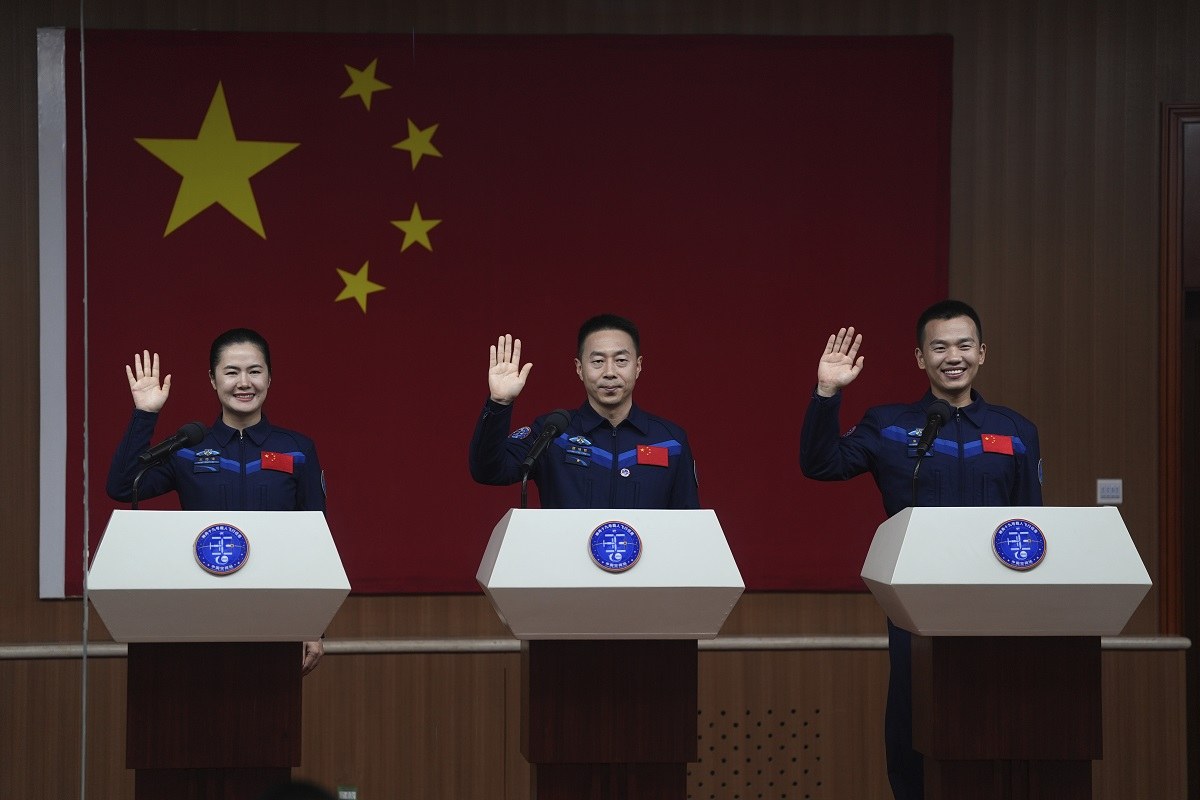China Says It’s Ready to Launch the Next Crew to Its Orbiting Space Station Early Wednesday

From left, Chinese astronauts Wang Haoze, Cai Xuzhe and Song Lingdong wave as they meet the press ahead of the Shenzhou-19 mission at the Jiuquan Satellite Launch Center in Jiuquan, northwestern China Tuesday, Oct. 29, 2024.

The launch pad for the Shenzhou-19 mission is seen during day break at the Jiuquan Satellite Launch Center in Jiuquan, northwest China Tuesday, Oct. 29, 2024.
17:48 JST, October 29, 2024
JIUQUAN, China (AP) — China said all systems are ready to launch the next crew to its orbiting space station early Wednesday, the latest mission to make the country a major space power.
The two men and one woman will replace the astronauts who’ve lived on the Tiangong space station for the last six months.
The new mission commander, Cai Xuzhe, went to space in the Shenzhou-14 mission in 2022, while the other two, Song Lingdong and Wang Haoze, are first-time space travelers both born in the 1990s.
Song was an air force pilot and Wang an engineer with the China Aerospace Science and Technology Corporation who will be the crew’s payload specialist. Wang will be the third Chinese woman aboard a crewed mission.
The three appeared at a brief news conference Tuesday behind protective glass, declaring their intention to carry out their scientific projects on the space station and “bring pride to the fatherland.”
The Shenzhou-19 spaceship carrying the trio is due to launch from the Jiuquan Satellite Launch Center in northwest China atop a Long March-2F rocket, the backbone of China’s crewed space missions. Launch time is set for 4:27 a.m., according to the space agency’s spokesperson Lin Xiqiang.
China built its own space station after being excluded from the International Space Station, largely due to the United States’ concerns over the program’s complete control by the People’s Liberation Army, the Chinese Communist Party’s military arm.
Besides putting a space station into orbit, the space agency has landed an explorer on Mars. It aims to put a person on the moon before 2030, which would make China the second nation after the United States to do so. It also plans to build a research station on the moon.
The moon program is part of a growing rivalry with the U.S. — still the leader in space exploration — and others, including Japan and India. America is planning to land astronauts on the moon for the first time in more than 50 years, though NASA pushed the target date back to 2026 earlier this year.
During the upcoming mission, the space station will receive resupplies from an uncrewed craft, aiding them in performing space walks and replacing and installing equipment to protect the Tiangong station from space debris, some of which was created by China.
According to NASA, large pieces of debris have been created by “satellite explosions and collisions.” China’s firing of a rocket to destroy a redundant weather satellite in 2007 and the “accidental collision of American and Russian communications satellites in 2009 greatly increased the amount of large debris in orbit,” it said.
The Shenzhou-19 astronauts will complete in-orbit rotation with the Shenzhou-18 trio and stay at the space station for approximately six months, witnessing the arrival of the Tianzhou-8 cargo craft and Shenzhou-20 crewed spaceship during the mission.
Many tasks await the new crew: conducting space science and application tests, performing extravehicular activities, installing protective devices against space debris, and installing and recycling extravehicular payloads and equipment. They will also engage in science education, public welfare activities and other payload tests.
The Shenzhou-19 astronauts are scheduled to return to the Dongfeng landing site in north China’s Inner Mongolia Autonomous Region in late April or early May next year, according to the agency.
Lin, the spokesman, said China has measures in place in the event that the astronauts must return earlier.
China launched its first crewed mission in 2003, becoming only the third nation to do so after the former Soviet Union and the United States. The space program is a source of enormous national pride and a hallmark of China’s technological advances over the past two decades.
China is looking toward further foreign cooperation in space and is in talks with partners to train astronauts and transport them to Tiangong, Lin said Tuesday.
"News Services" POPULAR ARTICLE
-

American Playwright Jeremy O. Harris Arrested in Japan on Alleged Drug Smuggling
-

Japan’s Nikkei Stock Average as JGB Yields, Yen Rise on Rate-Hike Bets
-

Japan’s Nikkei Stock Average Licks Wounds after Selloff Sparked by BOJ Hike Bets (UPDATE 1)
-

Japanese Bond Yields Zoom, Stocks Slide as Rate Hike Looms
-

Japan’s Nikkei Stock Average Buoyed by Stable Yen; SoftBank’s Slide Caps Gains (UPDATE 1)
JN ACCESS RANKING
-

Keidanren Chairman Yoshinobu Tsutsui Visits Kashiwazaki-Kariwa Nuclear Power Plant; Inspects New Emergency Safety System
-

Imports of Rare Earths from China Facing Delays, May Be Caused by Deterioration of Japan-China Relations
-

University of Tokyo Professor Discusses Japanese Economic Security in Interview Ahead of Forum
-

Japan Pulls out of Vietnam Nuclear Project, Complicating Hanoi’s Power Plans
-

Govt Aims to Expand NISA Program Lineup, Abolish Age Restriction

























